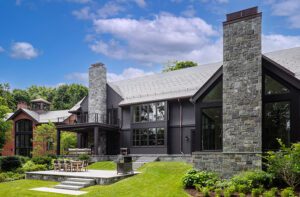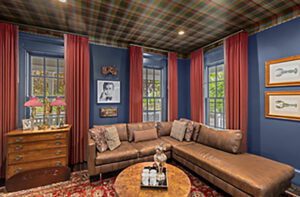No Boundaries
June 20, 2016
A Vermont-based printmaker transcends the limits of her medium, substituting felt for paper in multi-textured, mixed-media works inspired by the landscape of her native Australia.
Text by Robert Kiener
As Sarah Amos shows off some of the finished and in-progress colorful abstract prints that fill her barn-like northern Vermont studio, she reflects on how to describe what she does. “Am I a printmaker?” she asks, with a wry smile and just a hint of an Australian accent. “Hmm. Twenty years ago I would have said that, but today I think of myself as more of a trans-media artist. I’m a printmaker who is working in different media.”
Amos is internationally recognized for her prints, and her work has been collected in private, corporate, and museum collections, from Hanover, New Hampshire’s Hood Museum of Art to Melbourne, Australia’s LaTrobe University Museum to the permanent collection of Time Warner in New York City.
Amos studied printmaking in her native Australia, then moved to the United States, where she worked as a master printer in New York City and at the Vermont Studio Center. She has also taught printmaking at Bennington, Dartmouth, and Williams colleges.
The variety of art that hangs on the walls of her studio makes it clear that Amos’s artistic vision is constantly evolving. For example, after decades of printing on paper, she confesses she felt confined by limitations of size and texture. “I hated always having a seam in my work if I wanted to create a work bigger than a standard paper size,” she explains. “Cost was also an issue; a roll of Japanese paper can cost $800.”
Three years ago, while walking through a fabric shop in the nearby town of St. Albans, Vermont, Amos spotted a cream-colored bolt of felt and thought, “Hey, this looks like my Japanese paper!”
When she got home and unrolled it she was thrilled. “It was huge and had no seam. I could work as big as I wanted,” she remembers. She ordered thirty more bolts. “It was my aha moment.”
She has never looked back. “I jumped ship from paper to fabric,” she says. Since that chance discovery, she has been creating huge, mural-size collagraphic fabric constructions, using large pieces of cardboard and Plexiglas to make her plates. To create these fabric artworks, or “large-scale hybrid prints” as she also calls them, she employs many of the same techniques she uses on traditional prints, such as hand-inked plates.
However, she also adds layers, such as fabric collage pieces, hand stitching, three-dimensional appliqué elements, and more. “I am now able to combine my love of printmaking, painting, sculpture, and drawing, and merge them into one cohesive textile composition,” she says.
A fascination with geography and landscapes is a consistent element that runs throughout Amos’s work. “I am a visual archaeologist and am deeply curious about the ways the natural and scientific worlds intersect and cohabitate,” she says. Many critics have noted that suggestions of Australian geography and culture, such as Aboriginal art motifs or the colors, tones, and shapes of Ayers Rock, often appear in her work. “Landscape is an important element for me in my work, but it is not site specific,” says Amos. “It is the landscape of memory.”
She collects arcane scientific and geographical maps, and elements from these and other influences show up throughout her work. As one writer has noted, “Amos’s imagery suggests a variety of influences, such as architectural forms, geometry, and floral motifs, as well as references to a wide range of cultures, from Asian furniture to the Aboriginal arts and crafts of the Pacific Islands.”
Unlike most printmakers, Amos has always made only one print of each of her works, which range in price from $6,000 to $32,000. “I consider my prints to be like paintings,” she explains. “Also, I was a master printer for so long, where I helped artists make prints of their work, I got bored with the repetition.”
What’s next for Amos? She is off to Australia on one of her twice-yearly visits to her homeland and the place that still inspires her. “I’ve always been driven by this desire to push the boundaries of printmaking,” she says. “I am driven to see what my art would look like on another surface.”
Perhaps she will come back to her Vermont studio with a new technique to express her unique artistic vision. •
Editor’s note: To see more of Sarah Amos’s work, visit sarahamosstudio.com.
Share
![NEH-Logo_Black[1] NEH-Logo_Black[1]](https://b2915716.smushcdn.com/2915716/wp-content/uploads/2022/08/NEH-Logo_Black1-300x162.jpg?lossy=1&strip=1&webp=1)















You must be logged in to post a comment.